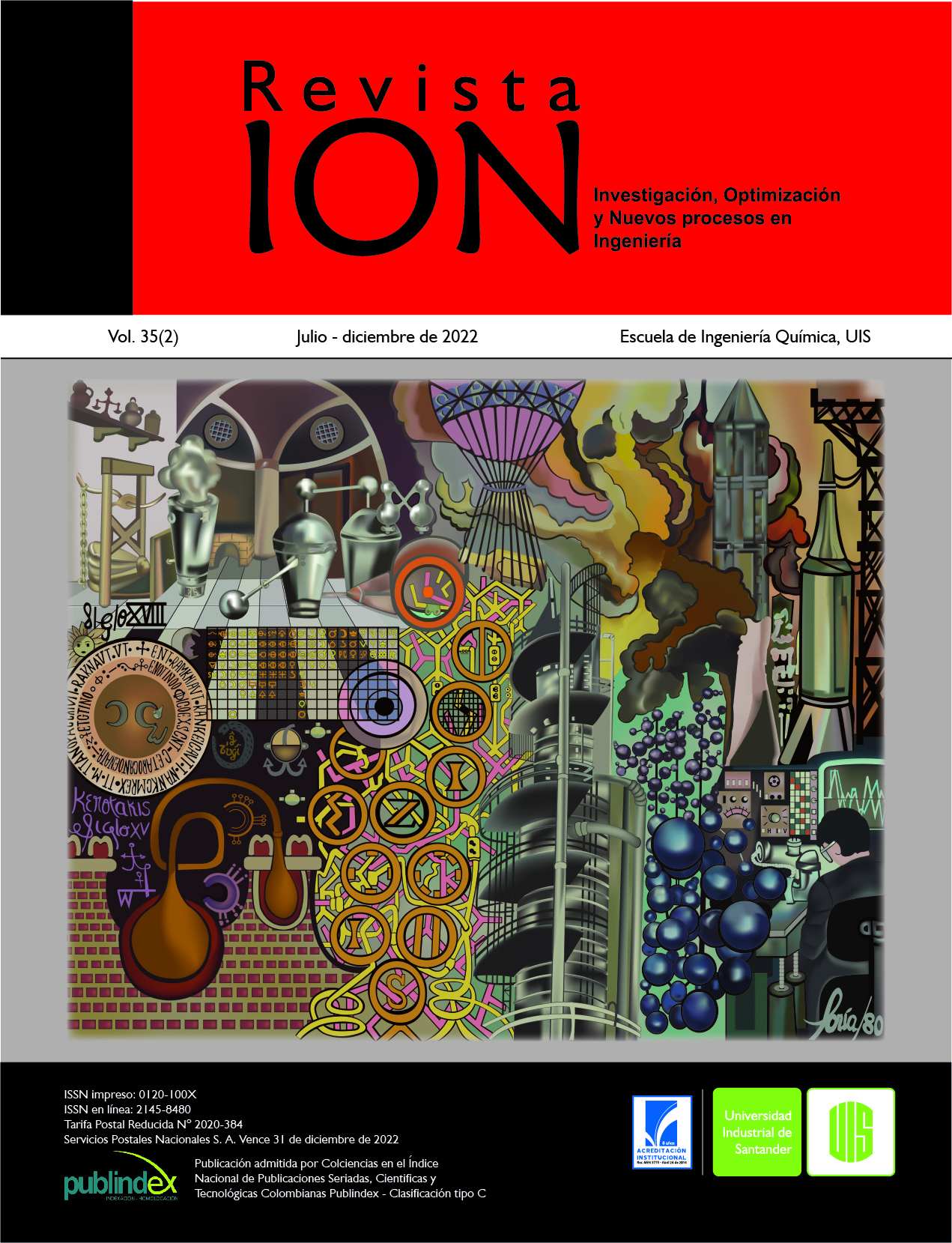Um olhar físico-químico sobre a solubilidade do propano em N-formil morfolina e sulfolano
Publicado 2022-12-02
Palavras-chave
- Propano,
- Solubilidade,
- Solvente Orgânico,
- Parâmetros Krichevsky-Ilinskaya,
- Peng-Robinson PR
- A constante do Henry ...Mais
Como Citar
Copyright (c) 2022 Brandon Smith Martínez Costa

Este trabalho está licenciado sob uma licença Creative Commons Attribution 4.0 International License.
Resumo
O gás propano mundial ou gás liquefeito de petróleo (GLP) tem sido amplamente utilizado para vários fins, como gás refrigerante, combustível, aquecimento; entre outros. Propano é um hidrocarboneto pertencente à família parafina, que é considerado solúvel em algumas substâncias orgânicas. O objetivo desta reflexão é abranger um estudo interpretativo e crítico sobre a solubilidade do propano em dois solventes orgânicos: morfolina N-formyl (NFM) e sulfolane em 298.15, 313.15 e 343.15 K, levando em conta as condições de pressão em obras já concluídas. Este trabalho inclui uma perspectiva físico-química para a análise da pressão e temperatura como os principais fatores quantitativos nos sistemas binários propano (2) + NFM (1) e propano (2) + sulfolane (1); destacando uma análise crítica e global sobre os parâmetros da equação Krichevsky-Ilinskaya (KI). Finalmente, e sob as condições estabelecidas, são discutidos os efeitos da equação de estado de Peng-Robinson (PR EOS), como o parâmetro de interação binária (BIP), a função alfa e algumas modificações.
Downloads
Referências
- Abbasov ZY, Fataliyev VM, Hamidov NN. The solubility of gas components and its importance in gas-condensate reservoir development. Pet. Sci. Technol. 2017;35(3):249-56. doi.org/10.1080/10916466.2016.1251459
- Granryd E. Hydricarbons as refrigetants-an overview. Int. J. Refrig. 2001;24(1),15-24. doi.org/10.1016/s0140-7007(00)00065-7
- Fleury D, Hayduk W. Solubility of propane in isomers of hexane and other non-polar solvents. Can. J. Chem. Eng. 1975;53(2):195-9. doi.org/10.1002/cjce.5450530207
- Mirgorod YA. Solubility of Ethane, Propane, and Butane in Aqueous Solutions of Sodium Dodecyl Sulfate. Russ. J. Gen. Chem. 2005;75(1):31-3. doi.org/10.1007/s11176-005-0167-4
- Jou F, Mather AE, Schmidt KA. Solubility of propane in N ‐formyl morpholine. Can. J. Chem. Eng. 2020;98(4):998-1002. doi.org/10.1002/cjce.23695
- Schmidt KA, Jou FY, Mather AE. Solubility of Propane in Sulpholane at Elevated Pressures. Can. J. Chem. Eng. 2008;84(2):256-9. doi.org/10.1002/cjce.5450840213
- Hayduk W, Wong CF. Solubility of propylene gas in octane and various polar solvents. Can. J. Chem. Eng. 1990;68(4):653-60. doi.org/10.1002/cjce.5450680417
- Mattson B. Microscale Gas Chemistry. Edu quím. 2005;16(4):514-528. doi.org/10.22201/fq.18708404e.2005.4.66089
- Miyano Y, Fukuchi K. Henry's constants of propane, propene, trans-2-butene and 1,3-butadiene in methanol at 255–320K. Fluid Phase. Equilib. 2004;226:183-7. doi.org/10.1016/j.fluid.2004.09.010
- Domańska U, Moollan WC, Letcher TM. Solubility of Sulfolane in Selected Organic Solvents. J. Chem. Eng. Data. 1996;41(2):261-5. doi.org/10.1021/je950236w
- Sciamanna SF, Lynn S. Solubility of hydrogen sulfide, sulfur dioxide, carbon dioxide, propane, and n-butane in poly (glycol ethers). Ind. Eng. Chem. Res. 1988;27(3):492-9. doi.org/10.1021/ie00075a020
- Henni A, Lal D, Mather AE. The solubility of ethane in n-methylpyrrolidinone. Can. J. Chem. Eng. 1996;74(3):423-5. doi.org/10.1002/cjce.5450740315
- Jou FY, Deshmukh RD, Otto FD, Mather AE. Solubility of H2S, CO2 and CH4 in N-formyl morpholine. Journal of the Chemical Society, Faraday Transactions 1: J. Chem. Soc. 1989;85(9):2675-82. doi.org/10.1039/f19898502675
- Peng DY, Robinson DB. A New Two Constant Equation of State. Ind. Eng. Chem. Fundam. 1976;15(1):59-64. doi.org/10.1021/i160057a011
- Prausnitz JM, Shair FH. A thermodynamic correlation of gas solubilities. AIChE. J . 1961;7(4):682-7. doi.org/10.1002/aic.690070430
- Jain D, Panda AK, Majumdar DK. Eudragit S100 entrapped insulin microspheres for oral delivery. AAPS PharmSciTech. 2005;6(1):E100—E107. doi.org/10.1208/pt060116
- Bradford ML, Thodos G. Solubility parameters of hydrocarbons. Can. J. Chem. Eng. 1966;44(6):345-8. doi.org/10.1002/cjce.5450440609
- Hildebrand JH. SOLUBILITY. J. Am. Chem. 1916;38(8):1452-73. doi.org/10.1021/ja02265a002
- Dariva C, Lovisi H, Mariac LC, Coutinho FM, Oliveira JV, Pinto JC. Propylene Solubility in Toluene and Isododecane. Can. J. Chem. Eng. 2008;81(1):147-52. doi.org/10.1002/cjce.5450810119
- Hayduk W, Asatani H, Miyano Y. Solubilities of propene, butane, isobutane and isobutene gases in n-Octane, Chlorobenzene and n-Butanol solvents. Can. J. Chem. Eng. 1988;66(3):466-73. doi.org/10.1002/cjce.5450660318
- Chappelow CC, Prausnitz JM. Solubilities of gases in high-boiling hydrocarbon solvents. AIChE. J. 1974;20(6):1097-104. doi.org/10.1002/aic.690200606
- Marufuzzaman M, Henni A. Solubility and diffusivity of propane in heavy oil and its SARA fractions. Can. J. Chem. Eng. 2014;92(8):1421-31. doi.org/10.1002/cjce.21977
- Myers AK, Myers AL. Prediction of mixed gas solubility at high pressure. Fluid. Phase. Equilib.1988;44(2):125-44. doi.org/10.1016/0378-3812(88)80108-0
- Orentlicher M, Prausnitz JM. Thermodynamics of hydrogen solubility in cryogenic solvents at high pressures. Chem. Eng. Sci. 1964;19(10):775-82. doi.org/10.1016/0009-2509(64)85088-0
- Patiño E, Aguilar G. Cinética de adsorción de propano y propileno en zeolita 5A-K. Adsorción irreversible inusual de propileno. Superf. Vacío. 2012;25(3),171-4. http://www.scielo.org.mx/scielo.php?pid=S1665-35212012000300005&script=sci_abstract
- Della Monica M, Jannelli L, Lamanna U. Physicochemical properties of sulfolane. J. Phys. Chem. 1968;72(3):1068-71. doi.org/10.1021/j100849a050
- Li X, Yang D. Determination of Mutual Solubility between CO2 and Water by Using the Peng– Robinson Equation of State with Modified Alpha Function and Binary Interaction Parameter. Ind. Eng. Chem. Res. 2013;52(38):13829-38.doi.org/10.1021/ie401365n
- Søreide I, Whitson CH. Peng-Robinson predictions for hydrocarbons, CO2, N2, and H2S with pure water and NaCI brine. Fluid Phase Equilib. 1992;77:217-40. doi.org/10.1016/0378-3812(92)85105-h
- Peng Dy, Robinson DB. Thermodynamics of Aqueous Systems with Industrial Applications WASHINGTON, D. C: AMERICAN CHEMICAL SOCIETY; Two- and Three-Phase Equilibrium Calculations for Coal Gasification and Related Processes; 1980. p. 393-414. doi.org/10.1021/bk-1980-0133.ch020
- Michel S, Hooper HH, Prausnitz JM. Mutual solubilities of water and hydrocarbons from an equation of state. Need for an unconventional mixing rule. Fluid Phase Equilib. 1989;45(2-3):173-89. doi.org/10.1016/0378-3812(89)80256-0
- Li H, Yang D. Modified α function for the Peng−Robinson equation of state to improve the vapor pressure prediction of non-hydrocarbon and hydrocarbon compounds. Energy Fuels. 2011;25(1):215-23. doi.org/10.1021/ef100927z
- Jou FY, Otto FD, Mather AE. The solubility of propane in 1,2-ethanediol at elevated pressures. J. Chem. Thermodyn. 1993;25(1):37-40. doi.org/10.1006/jcht.1993.1004
- Li X, Yang D, Zhang X, Zhang G, Gao J. Binary interaction parameters of CO2−heavyn- alkanes systems by using Peng–Robinson equation of state with modified alpha function. Fluid. Phase. Equilib. Junio de 2016;417:77-86. doi.org/10.1016/j.fluid.2016.02.016
- Jou FY, Schmidt KA, Mather AE. Solubility of Ethane in N-Formyl Morpholine. J. Chem. Eng. Data. 2003;48(2):224-5. doi.org/10.1021/je0255271
- Hildebrand JH, Lamoreaux RH. Solubility of Gases in Liquids: Fact and Theory. Ind. Eng. Chem. Fundam. 1974;13(2):110-5. doi.org/10.1021/i160050a004


